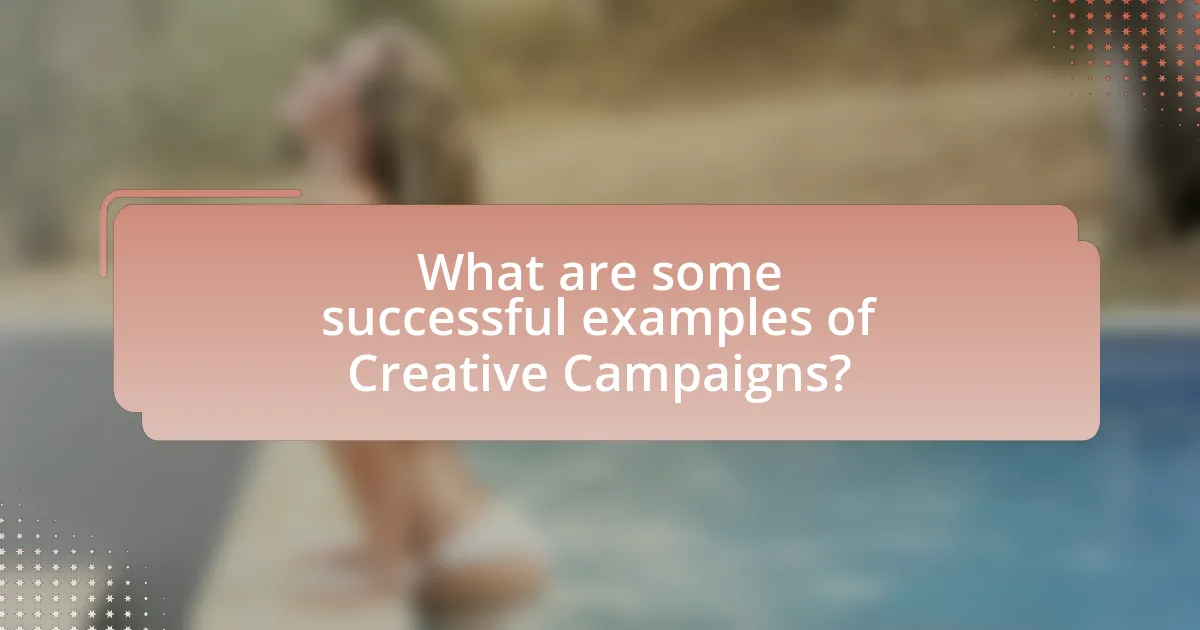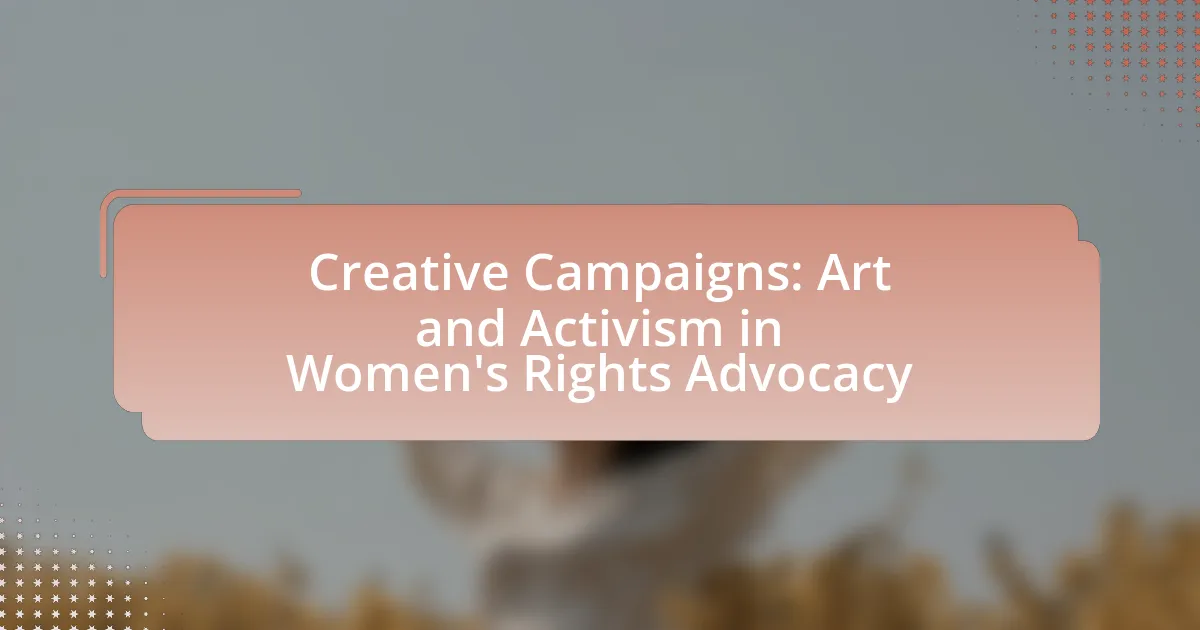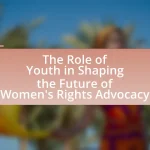Creative campaigns in women’s rights advocacy leverage artistic expression, media, and community engagement to promote gender equality and raise awareness about women’s rights issues. These campaigns utilize various forms of art, including visual art, performance, and digital media, to evoke emotions and inspire action. Successful examples, such as the “HeForShe” and “Me Too” movements, demonstrate the effectiveness of creative strategies in mobilizing support and driving social change. The article explores the role of art in activism, the impact of social media, and the challenges faced by activists, while highlighting best practices for effective advocacy campaigns.
What are Creative Campaigns in Women’s Rights Advocacy?
Creative campaigns in women’s rights advocacy are innovative strategies that utilize artistic expression, media, and community engagement to raise awareness and promote gender equality. These campaigns often incorporate visual art, performance, social media, and storytelling to effectively communicate messages about women’s rights issues, mobilize support, and inspire action. For example, the “HeForShe” campaign, launched by UN Women, creatively engaged men as advocates for gender equality, demonstrating the power of inclusive messaging in advocacy efforts. Such campaigns have been shown to increase public engagement and foster dialogue around critical women’s rights topics, thereby contributing to social change.
How do Creative Campaigns utilize art in activism?
Creative campaigns utilize art in activism by employing visual and performance art to communicate messages, evoke emotions, and inspire action regarding social issues. For instance, campaigns like “The Vagina Monologues” have used theatrical performances to raise awareness about women’s rights and violence against women, effectively reaching diverse audiences. Additionally, street art and murals, such as those created during the Women’s March, serve as powerful visual statements that challenge societal norms and promote gender equality. These artistic expressions not only engage the public but also foster community solidarity, making the messages more relatable and impactful.
What forms of art are commonly used in these campaigns?
Visual art, performance art, and digital media are commonly used forms of art in women’s rights advocacy campaigns. Visual art includes paintings, murals, and photography that convey powerful messages about gender equality and women’s empowerment. Performance art often involves live demonstrations or theatrical presentations that engage audiences emotionally and provoke thought on women’s issues. Digital media encompasses social media campaigns, videos, and online art exhibits that reach a broader audience and facilitate global conversations about women’s rights. These forms of art effectively communicate complex social issues and inspire action, making them integral to advocacy efforts.
How does art enhance the message of women’s rights advocacy?
Art enhances the message of women’s rights advocacy by providing a powerful medium for expression and emotional connection. Through visual art, performance, and literature, artists can convey complex themes of gender inequality, empowerment, and social justice in ways that resonate deeply with audiences. For instance, the “Women’s March” in 2017 featured a variety of art forms, including posters and performances, which effectively communicated the urgency of women’s rights issues, mobilizing millions globally. This artistic representation not only raises awareness but also fosters community engagement and solidarity, making the advocacy efforts more impactful and memorable.
Why are Creative Campaigns important for women’s rights?
Creative campaigns are important for women’s rights because they effectively raise awareness, mobilize support, and inspire action. These campaigns utilize innovative storytelling, visual art, and social media to engage diverse audiences, making complex issues more relatable and urgent. For instance, the “Me Too” movement leveraged social media creatively to amplify voices of survivors, resulting in significant cultural and legislative changes regarding sexual harassment. Such campaigns not only highlight injustices but also foster community solidarity and drive policy reforms, demonstrating their critical role in advancing women’s rights.
What impact do these campaigns have on public perception?
Creative campaigns in women’s rights advocacy significantly shape public perception by raising awareness and fostering empathy towards gender issues. These campaigns utilize art and activism to engage audiences emotionally, leading to increased visibility of women’s rights challenges. For instance, the “Me Too” movement, which gained traction through social media campaigns, resulted in a 20% increase in public awareness regarding sexual harassment and assault, as reported by the Pew Research Center. This heightened awareness often translates into shifts in societal attitudes, encouraging discussions and policy changes that support gender equality.
How do Creative Campaigns mobilize communities for change?
Creative campaigns mobilize communities for change by utilizing artistic expression to raise awareness and inspire collective action. These campaigns often employ visual art, performance, and multimedia to communicate messages that resonate emotionally with audiences, fostering a sense of shared purpose. For instance, campaigns like “The Vagina Monologues” have effectively highlighted women’s rights issues, leading to increased community engagement and activism. Research indicates that creative approaches can enhance participation rates by up to 50%, demonstrating their effectiveness in galvanizing community support for social change initiatives.

What strategies are employed in Creative Campaigns?
Creative campaigns employ strategies such as storytelling, visual engagement, and community involvement to effectively communicate messages and inspire action. Storytelling captivates audiences by presenting relatable narratives that resonate emotionally, while visual engagement utilizes striking imagery and design to capture attention and convey messages quickly. Community involvement fosters a sense of ownership and participation, encouraging individuals to contribute to the campaign’s goals. These strategies are supported by research indicating that campaigns incorporating storytelling and visual elements can increase audience engagement by up to 300%, demonstrating their effectiveness in advocacy efforts.
How do artists collaborate with activists in these campaigns?
Artists collaborate with activists in women’s rights campaigns by creating impactful visual and performance art that amplifies the activists’ messages. This collaboration often involves artists using their creative skills to design posters, murals, and installations that highlight issues such as gender inequality and violence against women. For instance, the “One Billion Rising” campaign utilized dance and performance art to raise awareness about violence against women, effectively merging artistic expression with activism. Additionally, artists participate in workshops and community events organized by activists, fostering dialogue and engagement around women’s rights issues. This synergy not only enhances the visibility of the campaigns but also mobilizes broader audiences to take action, as seen in various art-activism initiatives worldwide.
What roles do artists play in shaping the narrative?
Artists play a crucial role in shaping the narrative by using their creative expressions to communicate social issues and advocate for change. Through various mediums such as visual art, music, and performance, artists can highlight injustices, evoke emotional responses, and inspire action among audiences. For instance, the work of artists like Judy Chicago and her installation “The Dinner Party” has been instrumental in bringing attention to women’s history and rights, effectively altering public perception and discourse. Additionally, campaigns like “The Guerrilla Girls” utilize provocative art to challenge sexism and racism in the art world, demonstrating how artists can influence societal narratives and promote activism.
How can collaboration amplify the effectiveness of the campaign?
Collaboration can amplify the effectiveness of the campaign by leveraging diverse skills and perspectives to create a more impactful message. When various stakeholders, such as artists, activists, and community members, work together, they can combine their unique strengths to reach a broader audience and foster greater engagement. For instance, a study by the Stanford Social Innovation Review found that collaborative efforts in social movements can increase visibility and mobilization, leading to a 30% higher participation rate in advocacy events. This synergy not only enhances creativity but also builds a stronger network of support, ultimately driving more significant change in women’s rights advocacy.
What are the challenges faced by Creative Campaigns?
Creative campaigns face several challenges, including limited budgets, audience engagement, and measuring impact. Limited budgets restrict the scope and reach of campaigns, making it difficult to produce high-quality content or utilize diverse media channels. Audience engagement is crucial, as campaigns must resonate with target demographics to be effective; however, capturing attention in a saturated media landscape is increasingly difficult. Additionally, measuring the impact of creative campaigns poses a challenge, as quantifying emotional responses and social change is complex and often relies on qualitative data rather than straightforward metrics.
How do funding and resources affect campaign success?
Funding and resources significantly influence campaign success by enabling effective outreach, strategic planning, and impactful messaging. Adequate financial support allows campaigns to hire skilled personnel, utilize advanced technology, and create high-quality materials that resonate with target audiences. For instance, a study by the Pew Research Center found that campaigns with higher budgets are more likely to engage in extensive advertising and outreach efforts, leading to increased visibility and public support. Additionally, resources facilitate partnerships with influential organizations, enhancing credibility and reach. Therefore, the availability of funding and resources directly correlates with a campaign’s ability to achieve its objectives and mobilize support effectively.
What obstacles do activists encounter in promoting their message?
Activists encounter several obstacles in promoting their message, including censorship, lack of funding, and societal resistance. Censorship can manifest through government restrictions or social media algorithms that limit the visibility of their campaigns. For instance, in countries with authoritarian regimes, activists often face legal repercussions for expressing dissenting views. Lack of funding hampers the ability to create impactful campaigns, as many grassroots organizations rely on donations and grants that may not be readily available. Societal resistance arises from entrenched cultural norms and biases that oppose the activists’ messages, making it difficult to gain public support. According to a report by the International Center for Not-for-Profit Law, 50 countries have enacted laws that restrict the activities of civil society organizations, illustrating the systemic challenges activists face in their efforts.

What are some successful examples of Creative Campaigns?
Some successful examples of creative campaigns in women’s rights advocacy include the “HeForShe” campaign by UN Women, which mobilized men to advocate for gender equality and garnered over 1.2 million commitments from men worldwide. Another notable example is the “This Is What a Feminist Looks Like” campaign, which utilized social media to challenge stereotypes and promote diverse representations of feminism, reaching millions and sparking global conversations. Additionally, the “Girl Up” campaign by the United Nations Foundation empowers young girls to advocate for gender equality, successfully engaging over 1 million girls in advocacy efforts across 120 countries. These campaigns demonstrate the effectiveness of creative strategies in raising awareness and driving social change in women’s rights.
How have specific campaigns made a significant impact?
Specific campaigns have made a significant impact by raising awareness and driving legislative change in women’s rights advocacy. For example, the “Me Too” movement, which gained momentum in 2017, mobilized millions globally to speak out against sexual harassment and assault, leading to increased public discourse and policy reforms in workplaces. Additionally, the “HeForShe” campaign, launched by UN Women, successfully engaged men and boys in the fight for gender equality, resulting in commitments from various governments and organizations to promote women’s rights. These campaigns utilized social media and art to amplify their messages, demonstrating the power of creative activism in effecting social change.
What lessons can be learned from these successful campaigns?
Successful campaigns in women’s rights advocacy demonstrate the importance of emotional resonance, strategic partnerships, and clear messaging. Emotional resonance engages audiences effectively, as seen in campaigns that utilize powerful imagery and storytelling to highlight personal experiences, fostering empathy and connection. Strategic partnerships amplify reach and credibility; for instance, collaborations with influential organizations or public figures can enhance visibility and support. Clear messaging ensures that the campaign’s goals are easily understood, which is crucial for mobilizing action and support. These elements collectively contribute to the effectiveness of advocacy efforts, as evidenced by campaigns that have successfully influenced public opinion and policy changes.
How do these examples inspire future activism?
These examples inspire future activism by demonstrating the powerful impact of creative expression in advocating for women’s rights. Artistic campaigns, such as those utilizing visual art, performance, and social media, effectively engage diverse audiences and foster emotional connections, which can mobilize support and raise awareness. For instance, the “Women’s March” utilized art in its signage and performances to convey messages of solidarity and empowerment, resulting in one of the largest protests in U.S. history, with over 4 million participants in 2017. This illustrates how creative approaches can galvanize communities and inspire individuals to take action, thereby shaping the landscape of future activism.
What role does social media play in Creative Campaigns?
Social media serves as a crucial platform for amplifying creative campaigns, particularly in the context of women’s rights advocacy. It enables organizations and activists to reach a broader audience, facilitating engagement and participation through shares, likes, and comments. For instance, campaigns like #MeToo and #TimesUp gained significant traction on platforms such as Twitter and Instagram, mobilizing millions and fostering global conversations about sexual harassment and gender equality. The immediacy and accessibility of social media allow for real-time feedback and community building, which are essential for the success of advocacy efforts.
How does social media enhance outreach and engagement?
Social media enhances outreach and engagement by providing platforms for real-time communication and interaction, allowing organizations to connect directly with their audience. This immediacy fosters a sense of community and encourages participation in campaigns, as seen in movements like #MeToo, which gained global traction through social media channels. According to a study by the Pew Research Center, 69% of adults in the U.S. use social media, making it a vital tool for reaching diverse demographics and amplifying messages quickly. This broad reach enables advocacy groups to mobilize support, share resources, and create impactful narratives that resonate with followers, ultimately driving higher engagement rates.
What are the risks associated with using social media for activism?
Using social media for activism poses several risks, including misinformation, surveillance, and backlash. Misinformation can spread rapidly, leading to confusion and undermining the credibility of movements; for instance, during the Arab Spring, false information circulated widely, complicating the situation for activists. Surveillance by governments or organizations can lead to the identification and targeting of activists, as seen in various countries where online activity is monitored. Additionally, backlash from opposing groups can result in harassment or violence against activists, exemplified by the threats faced by individuals involved in movements like #MeToo. These risks highlight the complexities and dangers inherent in leveraging social media for advocacy efforts.
What best practices can be adopted for effective Creative Campaigns?
Effective creative campaigns can be achieved by ensuring clear messaging, audience engagement, and leveraging multiple platforms. Clear messaging involves articulating a concise and compelling narrative that resonates with the target audience, which is crucial for capturing attention and driving action. Audience engagement can be enhanced through interactive elements, such as social media challenges or community involvement, which foster a sense of participation and ownership among supporters. Leveraging multiple platforms, including social media, traditional media, and public events, maximizes reach and impact, allowing the campaign to connect with diverse demographics. Research indicates that campaigns utilizing a multi-channel approach can increase audience engagement by up to 300%, demonstrating the effectiveness of these best practices in driving successful outcomes.


